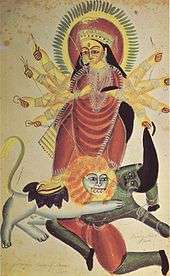Kalighat painting
| Part of a series on the |
| Culture of Bengal |
|---|
|
History
Genres Institutions
Awards
|
|
Music and performing arts |
|
Kalighat painting or Kalighat Pat originated in the 19th century Bengal, in the vicinity of Kalighat Kali Temple, Kalighat, Kolkata, India, and from being items of souvenir taken by the visitors to the Kali temple, the paintings over a period of time developed as a distinct school of Indian painting. From the depiction of Hindu gods, god, and other mythological characters, the Kalighat paintings developed to reflect a variety of themes.
History


In the nineteenth century, the only school of painting that was flourishing in Bengal was the traditional art of scroll paintings that was popular in the rural areas. These paintings were done on cloth or patas. They depicted conventional images of gods and goddesses and scenes from epics like Tulsidas’ Rama charita manas. The artistes were villagers who travelled from place to place with their scroll paintings and sang the scenes from the epics depicted in the paintings during village gatherings and festivals. These artists, called patuas or ‘painters on cloth’ were said to be half Hindu and half Muslim and practised Islam.
The British: as patrons of this art

Meanwhile, the British, having established themselves in the country politically started to evince interest in art, literature, and music. They set up institutions that imparted a European style of academic training to Indian artists. The Calcutta School of Art was one such school and attracted traditional artists–the patuas—to the city. Initially these artists were concentrated around the temple at Kalighat where there was a demand for religious art. Gradually, they started to learn from the newer techniques and discovered that these could help them increase their earnings. They started creating new forms of art and the Kalighat painting was born.
Oriental and Occidental Kalighat
The Kalighat School was an agreeable and unique blend of two different styles of painting—the Oriental and the Occidental—and steadily gained popularity. Among the deities that the Kalighat artists painted, the goddess Kali was a favorite. Images of Durga, Lakshmi, and Annapurna were also popular, especially during the Durga Puja festival. The artists also portrayed themes like Sita-Rama, Radha-Krishna and the exploits of Hanuman. Another theme depicted, dear to the Bengali ethos, was that of Chaitanya Mahaprabhu and his disciples. But the Kalighat artists did not restrict themselves to religious themes. Their paintings depicting different professions and costumes were also popular with the tourists. Even contemporary events like crime were the subject of many paintings. The artists also chose to portray secular themes and personalities and in the process played a role in the Independence movement. They painted heroic characters like Tipu Sultan and Rani Lakshmibai.
Capturing Daily Life
An important achievement of the Kalighat artistes was that they made simple paintings and drawings, which could easily be reproduced by lithography. Such prints were then hand coloured. This trend continued up to the early part of the twentieth century and these paintings ended up in museums and private collections. The charm of the Kalighat paintings lies in the fact that they captured the essence of daily life and they influence modern artistes like the late Jamini Roy even to this day.
Further reading
- Chaitanya, Krishna (1994). A history of Indian painting: the modern period. New Delhi: Abhinav Publications. pp. 112–118. ISBN 978-81-7017-310-6.
- Kalighat Paintings ISBN 81-7436-135-9, by Aditi Nath Sarkar and Christine Mackay
- Kalighat Painting: Images from a Changing World (Ahmedabad and Middleton, NJ, 1999)
- Kossak , Steven (1997). Indian court painting, 16th-19th century.. New York: The Metropolitan Museum of Art. ISBN 0870997831. (see index: p. 148-152)
See also
- Indian painting
- Madhubani painting
- Mughal painting
- Rajput painting
- Tarakeswar affair: a common theme in the paintings
External links
| Wikimedia Commons has media related to Kalighat painting. |
- Kalighat Paintings of West Bengal
- Som, Sovon (2012). "Kalighat Painting". In Islam, Sirajul; Jamal, Ahmed A. Banglapedia: National Encyclopedia of Bangladesh (Second ed.). Asiatic Society of Bangladesh.
- Drawings and Paintings of Kalighat by Mukul Dey
- Showcase: Kalighat painting at National Gallery of Modern Art
- The Painters of Kalighat: 19th Century Relics of a Once Flourishing Indian Folk Art Killed by Western Mass Production Methods by Mukul Dey
